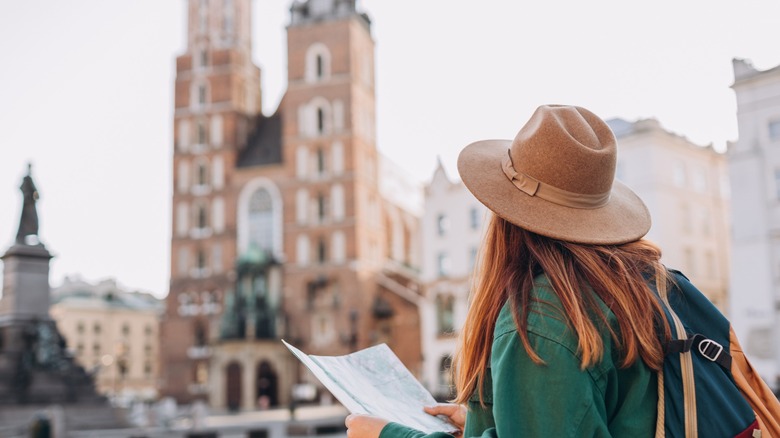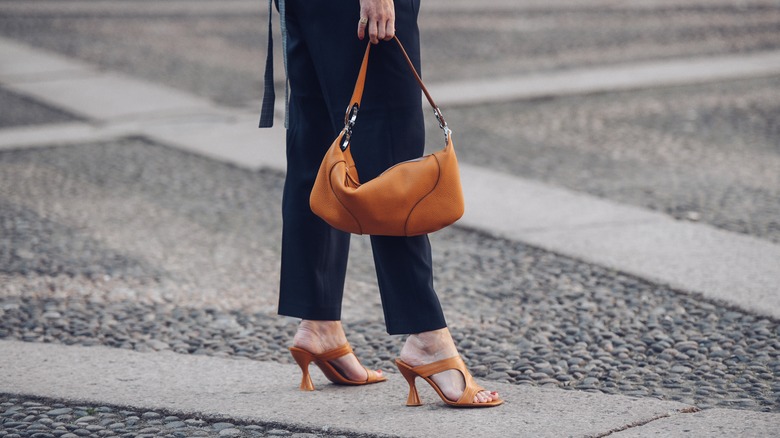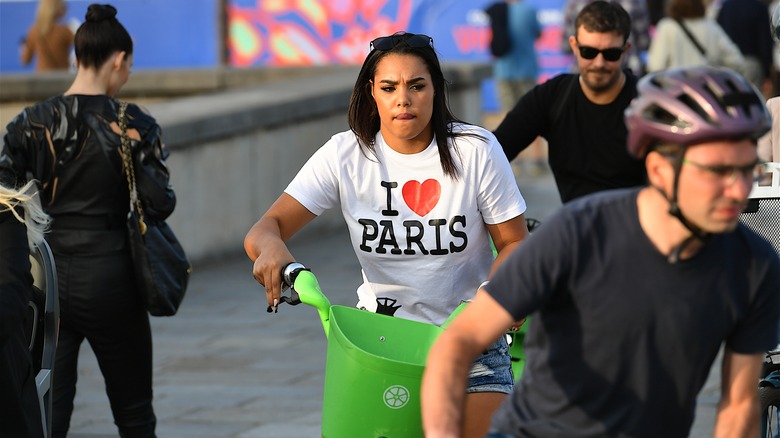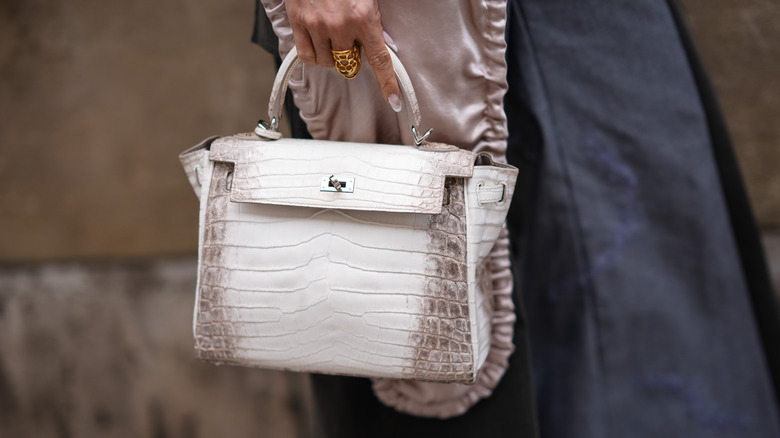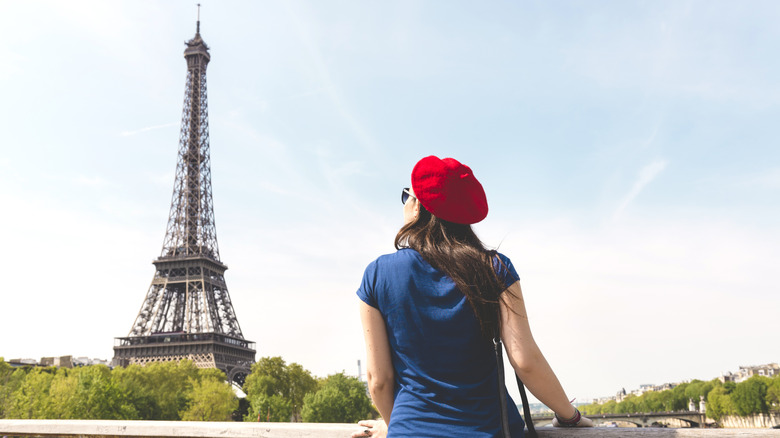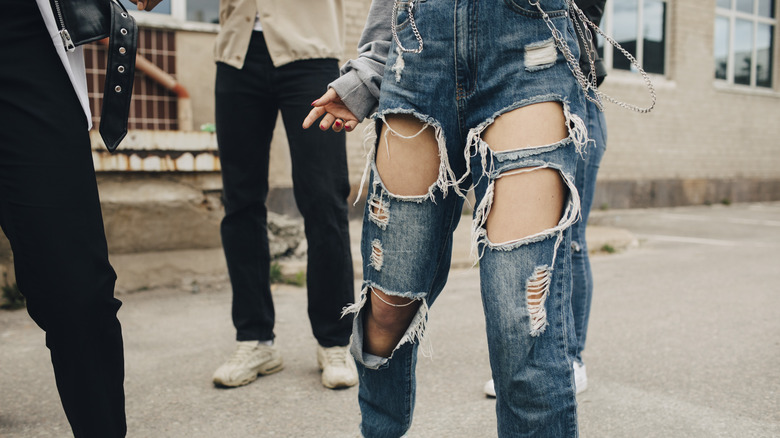Common Clothing Mistakes To Avoid On A Trip To Europe
When you're packing for a trip to Europe, every square inch of real estate matters. Far too many American tourists make the mistake of loading up their suitcases with clothing items that aren't practical for walking around European streets. By wearing these pieces, you might as well be a neon sign flashing: "American tourist." Depending more or less on where you find yourself in the United States, Americans have a tendency to dress boldly. Wacky t-shirts, camouflage, funky prints — U.S. citizens love to make strong fashion choices. But what flies under the radar at Walmart or even your local Trader Joe's will likely make you stand out more than you want, whether in the seaside Croatian town that's like Venice without the crowds or the streets of Amsterdam's Jordaan.
No matter how you dress, there's a fair chance you're going to stand out to some degree, but certain clothing choices illuminate tourists even more, potentially making you a target for opportunistic pickpockets and scammers. On the other hand, dressing a bit more like the locals can help avoid unwanted stares or even prevent you from overstepping unspoken social boundaries. Local folks will also know more about what's most comfortable for getting around in a city than tourists, from temperature-abiding pieces to footwear. In other words, making the most of your suitcase footprint begins with understanding what Europeans are wearing — more to the point, what they aren't wearing.
Bold and bright clothing is a tourist giveaway
Although there are always exceptions, generally speaking, Europeans have a reputation for dressing in understated fashions and colors while avoiding things that will draw attention to themselves. To avoid telegraphing your tourist vibes, NYC fashion blogger Kelsey Barnes suggests leaving your vivid colors, bold patterns, and graphic tees at home. Anything that's particularly eye-catching, whether it's a brightly-colored sweater, zippy plaid or polka-dot skirt, neon tie-dye, Hawaiian shirt, or even your favorite colorful Golden Girls print will likely draw a fair amount of attention in many European countries. Along those same lines, you're better off leaving obvious synthetic fabrics like pleather, velour, and shiny polyesters at home.
While it's not true everywhere, many European countries tend to favor natural-looking fabrics and black and muted colors. As Rick Steves community user Christe” explained, "The idea of black is that it goes with everything, shows dirt less quickly, and is a 'sophisticated' look. It just makes things easy." If you've ever found yourself nearing the end of a vacation with nothing that matches, you understand the value of this approach. When your luggage is full of mix-and-match pieces in black, solid colors, and muted neutrals, just about anything in your suitcase will end up looking good together. Simple neutral outfits are also easy enough to dress up by adding a pop of color with a pretty pashmina or cardigan.
Consider skipping the stilettos
If your plans involve walking around European streets, say, the hidden gem spots Rick Steves recommends instead of these tourist-infested ones, your first consideration when packing shoes should be comfort. A good pair of walking shoes is essential when you're going to be trekking around a city with public transportation and walkable streets. Depending on where you're traveling, it's probably best to leave the flip-flops at home since they are not very practical for putting in thousands of steps on medieval streets, and your feet will become wet and dirty.
For women who prefer a little height in their heels, it's a good idea to research the city you're visiting or, better yet, bring a couple of options along and feel out the local vibe. While it's not uncommon to see women wearing high heels with their casual or semi-casual attire in the United States, the popularity of high heels around town depends on the European city you're visiting. Add to that the type of streets you'll be walking around on (stilettos are impractical for cobblestone streets, and the wearer might be uncomfortable). In Barcelona and Lisbon, for example, most women tend to wear flats or low heels unless they're heading out for a night on the town. On the other hand, Croatian and Balkan women love their heels. As one Redditor in r/AskEurope puts it, "Croatia: women wear heels even on the beach. Heels everywhere."
Save the yoga pants for the studio
Given that wearing yoga pants as activewear around town is controversial in some circles in the United States, it should probably come as no shock that they're not universally accepted as casual attire across Europe. According to many Redditors, wearing any type of casual athletic wear like yoga pants and leggings is fine for a quick trip to the store, but it's not the sort of thing you'd wear around town in most European countries.
In the United Kingdom, some see yoga pants as a class marker. As u/j_svajl observed in r/AskEurope, "In the U.K. wearing clothes of that type means you're either poor working class or a bougie (if you're wearing the correct brand of yoga pants, carry a takeaway latte, etc.)." Echoing the sentiment on r/Europetravel, u/jredland emphasized: "Yoga pants are not usually worn outside the gym."
While it seems like the American habit of wearing yoga pants as everyday pants is certainly picking up steam in some countries, with Redditors in French cities like Aix-en-Provence and Strasbourg reporting seeing them around town, they're hardly the norm. This also seems to be more of a trend among younger generations. While hoodies are probably fine, any attire that is especially tight or casual is probably best left at home, no matter what age group you fall under.
Avoid t-shirts that announce you're a tourist
For some folks, printed t-shirts are a way of life. They're simple, comfortable, easy to wear, and go well with everything while serving as the ultimate mobile icebreaker by declaring to the world that you love dogs or can't get enough Dr. Pepper. But to many Europeans, t-shirts — particularly certain kinds — are a fashion faux pas. Take it from Kaarina, a Finnish woman who complained on Rick Steves' Europe community forum, "For me the main thing is the logos. I am a Euro and I would never wear a logo on a shirt because to me it looks childish." She went on to express her disdain for shirts printed with designer logos, calling them "tacky."
Although it's worth noting that not every European feels this way and every European country is different, certain types of graphic t-shirts are more likely to make you stand out as a tourist. A shirt with an American sports team — or any type of sports logo clothing for that matter — will likely draw some attention in a country where football means something different than it does in the United States. If you're actively looking for ways to avoid making yourself a target for criminals, it's better to stick to solid tees or shirts with minimal graphics to be on the safe side.
Luxury bags could end up stolen
For many women, no outfit would be complete without a charming Chanel envelope purse or a smart-looking Hermès handbag. If you bring one along, you're certainly not going to stand out on the streets of Europe. Just like American women, Euro gals can often be seen with their finest bags in tow. Equally worth noting, there are just as many passable knock-offs floating around European streets, so the chances of thieves stealing your bag are about the same anywhere else.
But unlike a quick outing for lunch or shopping back home, you're most likely to spend some pretty long days exploring cities you've never seen before — which means you're more likely to be distracted by all of the cool sights you're taking in. And if you lose track of your high-end handbag in Vienna or Belgium, you're even less likely to find it again than you would be at home. Take it from Redditor u/26washburn, who advised on r/luxurypurses: "Having been ripped off of a bag in a very nice restaurant abroad, I no longer carry or wear branded luxury items when traveling." If you are still committed to carrying your best bag, opt for a cross-body bag since it can't be easily ripped from your shoulder while you're walking, and make sure it's got a zippered closure. If your handbag or any clothing articles are particularly valuable, it's also worthwhile to invest in travel insurance.
Leave your expensive jewelry at home
Much like your higher-end handbags, it's probably not a good idea to travel with expensive jewelry. Even if you think it will be safe on your body, expensive-looking jewelry could get you robbed, especially in certain areas where crime is high. While folks in most European countries are just as likely to have fancy baubles as Americans, they tend to reserve them for special occasions rather than wearing them around town. Like the bold prints you left at home, many Europeans — particularly Italians — see glittering jewels as a little too over-the-top for everyday wear.
Take it from Redditor u/zaise_chsa, who advised on r/ItalyTravel, "I would avoid jewelry at all when walking in a city you don't know. When I was in Milan last year, ... [I] saw an old woman have her very minimal necklace ... snatched off her neck." For instance, this popular city in Italy that Rick Steves doesn't recommend for everyone is notorious for its crime. Its thieves are often aided by motor scooters and their knowledge of Italy's narrow streets, making it easy for them to grab your goods and be gone before you realize what's happened. Even if your jewels don't get nabbed, wearing high-value jewelry is just another way to stand out, making you a mark for hustlers and pickpockets. If you absolutely must travel with expensive jewelry — say for a wedding proposal — keep it stashed in your hotel safe when you're not using it.
Don't bring a backpack or bag without a lock
When you're planning to spend the day hopping public transportation and walking around Europe's medieval winding streets, you'll most likely need a bag to stash necessities like a light jacket for layering, any travel guides you might need, and a water bottle. But just as you should when walking around any major American city, make sure your backpack or hip bag is thief-proof. Pickpocketing and theft are especially common on public transportation that forces people to crowd together and let down their guard. As one Redditor warned on r/Europetravel, thieves will surreptitiously slice the straps on someone's backpack or bag so they can easily take off with it once the doors open.
Many luggage brands offer backpack travel locks, and you can even pick up hip bags with built-in locks and metal-reinforced material so the storage accessory can't be easily sliced away with a knife or razor blade. Many of these bags even come with RFID blocking, so your credit card information or passport can't be scanned and duplicated. While situational awareness will always be the best way to ward off thieves and pickpockets, knowing that your backpack or bag can't easily be opened or cut off of your body frees you to focus on taking in the sights.
Wearing traditional attire might make you stand out
If we've learned nothing else from Clark Griswold, wearing a beret in Paris is just a little touristy. Even so, Reddit is brimming with tales of travelers learning this lesson the hard way. Take u/drumorgan, who, on r/travel, recounted such an experience, "In Ireland, I bought a real wool cap and was so proud. I walked into a bar full of guys wearing American baseball caps, and they asked me where I was from. I said, what gave it away? They said, "Do you see one single person in this bar wearing that 'authentic' cap?" On the same subreddit, Redditor u/ApolloBiff16 shared a similar experience: "I lived in France for a bit (plan to return), and I bought a really nice authentic beret. Naturally, no one still wears those (especially not men)."
While you won't exactly win any cool kid points wearing berets or flat caps around town, that's not to say you shouldn't buy these tourist-fave souvenirs, particularly when you're purchasing them from small, local businesses. There are some spots in Europe where traditional attire actually will earn you cool points. As it turns out, many Germans love it when tourists wear tracht — that's the German word for traditional attire like lederhosen and dirndl. Similarly, most Scots will happily welcome new members to the kilt club, so feel free to tartan away.
Overly ripped jeans aren't as common in most European cities
There once was a time when ripped jeans were a sign of the American counterculture. While denim is every bit as popular in most European countries, ripped jeans are not nearly as favored, particularly the ones that prefer a more conservative aesthetic overall. If you're traveling to the United Kingdom, your ripped jeans are probably fine since, much like the U.S., they tend to come in and out of style, along with mom jeans, skinny jeans, and every other denim product to cycle through the fast fashion world. This seems to be more or less true in Germany as well.
But if you're traveling through Spain, Italy, or France, you'll want to go for a more polished and put-together look right down to the jeans. Redditor u/EniAcho observed of Italians on r/TravelHacks, "Even if they wear a t-shirt and jeans, the clothes will be very well fitted, have some style to them, and may be worn with leather sandals or loafers rather than sneakers." Writing on the Rick Steves' Europe community forum, a user named Carlos wrote: "Yes we wear blue jeans in Spain too! Though I notice tourists (especially from the U.S.) usually wear a baggy-er cut of jeans, for comfort, of course. In Spain, one mostly sees a tighter cut, usually with more different colours than blue, like red or a lighter colour."
Packing excessively casual pieces is a common clothing mistake for Europe
Careful clothing choices when traveling to Europe are one of the top travel tips we've learned from Rick Steves. According to the travel expert, Americans generally dress more casually than Europeans, who do not wear shorts and tank tops much — in some cases, such attire is considered inappropriate. This is because the European sense of casual tends to be somewhat more formal than what Americans are used to. Before booking your flight ticket, you might want to check out what he considers the common clothing mistake tourists make on a trip to Europe.
Steves notes on his blog, "Shorts are uncommon on older women and in big cities, and the cutoff temperature for "hot enough for shorts" is much higher than in the U.S." This is especially true in southern Europe, and some religious sites may even require their guests to dress modestly. As an alternative to shorts, women should consider packing an airy skirt, a pair of capri pants, or breezy palazzo pants. For men traveling to Europe during the hotter months, try to go for the lightest fabric pants you can find. Of course, not all Europeans think alike. Even on this beach in Portugal deemed one of the world's most dangerous, locals can't wait to break out their shorts when the temperature starts to rise.
